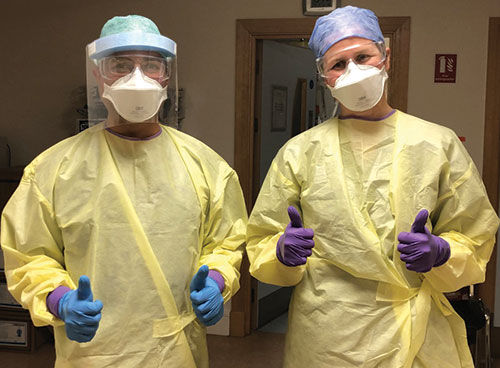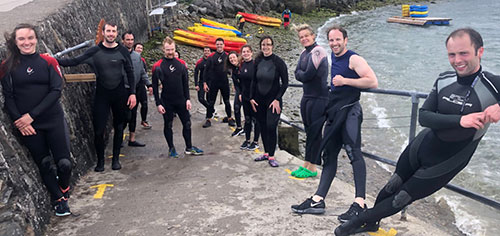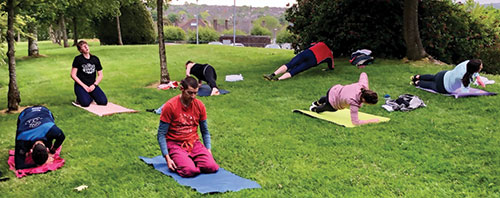Personal reflections: connection through COVID
We collectively watched the accelerating COVID-19 train closing in: powerless to
influence its course, a terrifying run away. Ireland, hopelessly under-prepared for
pandemic, announced the closure of schools, colleges, universities and childcare
facilities on 12 March, the first in a series of societal and economic shutdowns.
Juxtaposition of information vacuum and information overload
best describes the past five months. Anxiety, uncertainty and fear
resonated throughout work and home environments. Both the
healthcare system and our collective neurohormonal responses
were on high alert. Tensions and irritability were evident. In
the space of a short few weeks, our personal and professional
worlds were flipped at a weird dystopian angle. Elective work
was cancelled. Education sessions were transformed into PPE
drills and ventilation tutorials. Intensive care reorientation was
hastily prepared for consultants and trainees alike. Physical
barriers, physical distance, facemasks, online meetings and
‘Zoom tutorials’ became the overnight norm.
We are struck by the impact the pandemic has had on human
connection. Johann Hari’s ‘Lost Connections’ describes mental
health challenges in terms of connections lost to self and others.
Connection is fundamental to the human experience. When we
feel connected we feel supported. When we feel supported we
feel safe. When we feel safe we are undefensive and we thrive.
Lost connections fuel anxiety, stress and fear.
Work-related stress unconsciously transferred home. Arrival
home became a ritualised decontamination procedure; flight-or-fight responses permanently switched on. Hugs and kisses
foregone for fear of transmitting an invisible pathogen. Social
distancing became social isolation, grandparents cocooned
away. ‘At-risk groups’ limited contact with other human beings.
As anaesthesiologists we wear enhanced PPE. As citizens
we stand 2 m apart from, and glance awkwardly at, others.
Handshakes, hugs and normal physical contact are distant
memories. Mundane everyday tasks often mushroomed into
enormous undertakings. A simple trip to the supermarket was
frequently the final straw. Breathe, just breathe…connect to self.
Breathe, feel, hear, move, observe
Breathe, feel, hear, move, observe. When you feel your
body, notice your breath, sense your environment, tune into
thoughts and emotions, and move in a way that connects
these experiences, you are practicing yoga. You are practicing
connection. Connection to breath is connection to self. Slowing noticing your environment is a deeply supportive practice
that can be utilised at any time and anywhere. Polyvagal
theory proposes that vagally-mediated parasympathetic tone
enhances social engagement and feelings of safety, wellness
and connection. Connection to breath and engaging vagal tone
dampens the stress response. This practice is invaluable as work
and home life collide head-on.
Connection to others can be mediated by small deliberate
investments. Connection to colleagues within the workplace
has fostered trust and collaboration in recent times. Our
framework for this investment originates in the Blue Zones®
project. The brainchild of National Geographic Fellow Dan
Beuttner, this project systematically analysed human society
from the perspective of health, longevity and happiness. The
key elements of a
blue zone can be summarised as: movement;
sense of purpose and belonging; taking time to slow down
and decompress; putting loved ones first, and not over-eating. In the era of
COVID-19, can the workplace be a Blue Zone?

A connected work environment is a safe place that embraces
and values inclusivity. A sense of connected community within
our department was facilitated by integrating Blue Zone core
elements. A number of years ago, members of our department
deliberately embarked on a series of small initiatives to improve
connection between colleagues.
Days spent zip-lining, kayaking, cycling and ice-skating
enhanced the work environment by connecting colleagues in
ways not possible through work alone. Consultants and trainees
shed professional roles and ranks, becoming vulnerable while
‘playing’ together. This vulnerability and willingness to share
oneself brought a new dynamic to the workplace that is difficult
to adequately characterise or quantify.

As COVID-19 hit, a trusted friend and yoga teacher developed
a mindfulness and movement practice to meet the specific
needs of healthcare workers. This
resource is free to all, and
has been shared worldwide through personal contacts. These
practices connect us the ground, our breath, our bodies and our environment, fostering a sense of wellness and safety. Noticing
sounds, colours, texture and smells brings a state of mindful
awareness. Tuning into one’s senses gives one’s nervous system
important safety cues. Sensing one’s body, the ground and the
environment establishes mindful contact with self, which may
mitigate contact lost with others.
‘Wake-up, shake-up’ is now the new norm. A 07:00 standing
appointment to meet for a combination of high intensity interval
workouts and yoga on grass, beneath trees, within the hospital
grounds. The positive effect on those who participate has been
evident. Fun and friendship have been deliberately injected into
our often hectic and stressful workday.

‘Coffee and a gas’ provides an opportunity to develop tribe,
and to downshift at work. We embraced the Association of
Anaesthetists’ initiative, and hosted monthly scheduled downtime,
bringing colleagues together over coffee to chat. Over time,
rebranding of this monthly staple brought us ‘pizza and a gas’,
‘curry and a gas’ and ‘Christmas and a gas’. Social distancing
makes this initiative difficult but not impossible. This is an
important vehicle to connect and decompress with those beside
you in the trenches.
The SARS-CoV-2 virus has challenged our sense of personal and
professional being as nothing in living memory. Our strategy to develop and nurture a connected professional environment
lessened the blow of workplace and work pattern changes.
Adopting practices that enable connection to self and others
is essential to successful human endeavour. The Blue Zone
workplace might provide a template for enhanced connection
and a better work environment.
Life is slowly developing a rhythm that resembles a new normal.
We all look forward to the day when the company of family and
friends can be enjoyed, without the spectre of COVID-19 lurking
in the background.
Damian Barry
Consultant Anaesthesiologist
Cork University Hospital, Cork
Jessica Hatchett
Yoga Instructor
Flow Yoga Centre,
Clonakilty, Co. Cork
Brian O’Donnell
Consultant Anaesthesiologist
Cork University Hospital, Cork
Twitter: @damobaz87; @yogawestcork; @briodnl